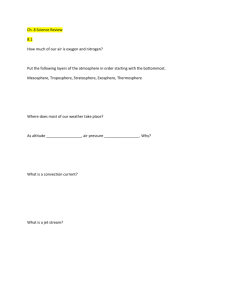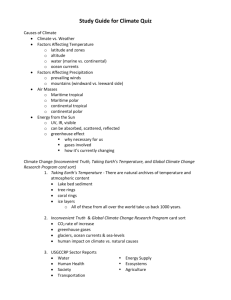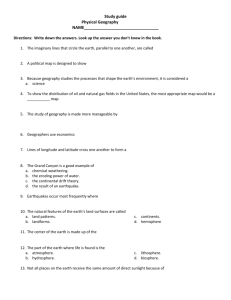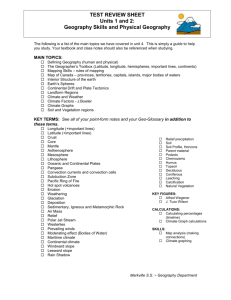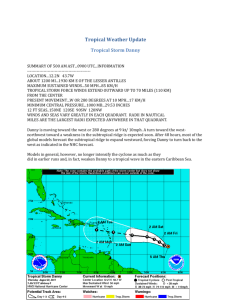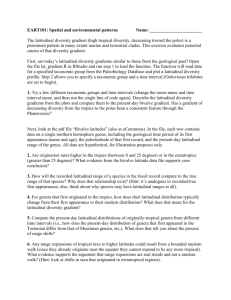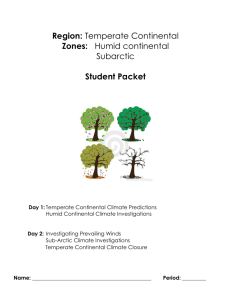Physical Geography Notes
advertisement
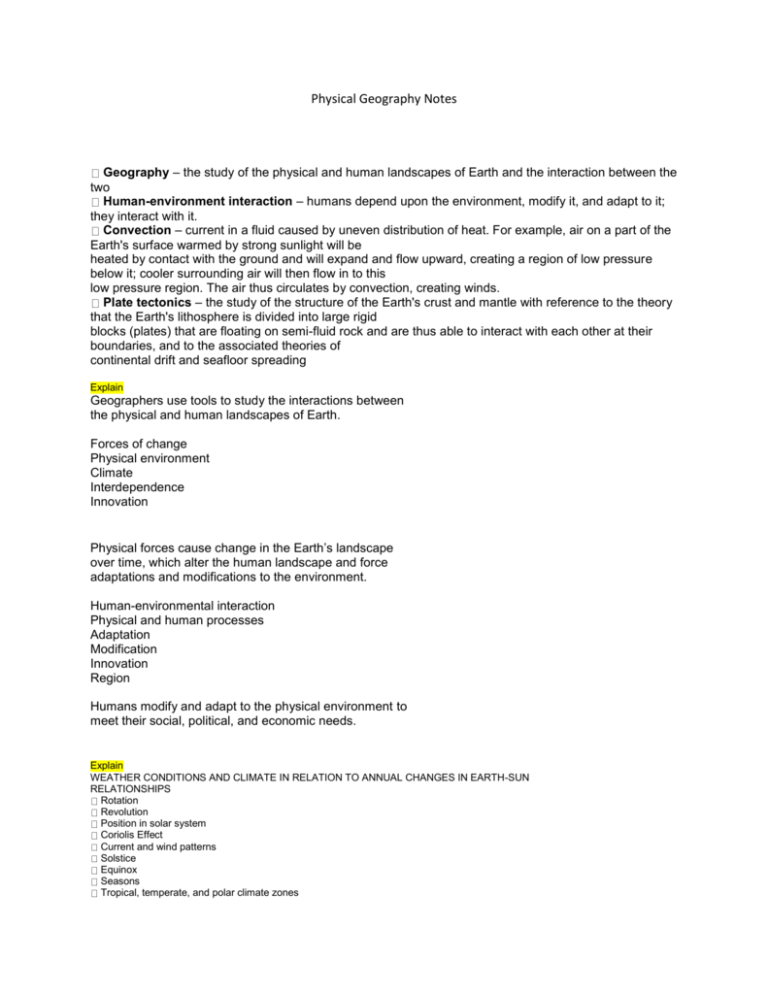
Physical Geography Notes Geography – the study of the physical and human landscapes of Earth and the interaction between the two Human-environment interaction – humans depend upon the environment, modify it, and adapt to it; they interact with it. Convection – current in a fluid caused by uneven distribution of heat. For example, air on a part of the Earth's surface warmed by strong sunlight will be heated by contact with the ground and will expand and flow upward, creating a region of low pressure below it; cooler surrounding air will then flow in to this low pressure region. The air thus circulates by convection, creating winds. Plate tectonics – the study of the structure of the Earth's crust and mantle with reference to the theory that the Earth's lithosphere is divided into large rigid blocks (plates) that are floating on semi-fluid rock and are thus able to interact with each other at their boundaries, and to the associated theories of continental drift and seafloor spreading Explain Geographers use tools to study the interactions between the physical and human landscapes of Earth. Forces of change Physical environment Climate Interdependence Innovation Physical forces cause change in the Earth’s landscape over time, which alter the human landscape and force adaptations and modifications to the environment. Human-environmental interaction Physical and human processes Adaptation Modification Innovation Region Humans modify and adapt to the physical environment to meet their social, political, and economic needs. Explain WEATHER CONDITIONS AND CLIMATE IN RELATION TO ANNUAL CHANGES IN EARTH-SUN RELATIONSHIPS Rotation Revolution Position in solar system Coriolis Effect Current and wind patterns Solstice Equinox Seasons Tropical, temperate, and polar climate zones Types of precipitation Latitudinal Location Describe PHYSICAL PROCESSES THAT AFFECT THE ENVIRONMENTS OF REGIONS Weather Tectonic Forces Erosion Soil-building Orographic Effect Examine PHYSICAL PROCESSES THAT AFFECT THE LITHOSPHERE, ATMOSPHERE, HYDROSPHERE, AND BIOSPHERE The 4 spheres of the Earth’s system. Physical processes that affect the lithosphere, atmosphere, hydrosphere, and biosphere Explain HOW ELEVATION, LATITUDE, WIND SYSTEMS, OCEAN CURRENTS, POSITION ON A CONTINENT, AND MOUNTAIN BARRIERS INFLUENCE TEMPERATURE, PRECIPITATION, AND DISTRIBUTION OF CLIMATE REGIONS Including, but not limited to: Factors that influence the various types of climate regions Prevailing winds Latitudinal location Ocean currents (warm and cold, i.e. Gulf Stream, North Atlantic Drift, Humboldt Current) Elevation Global, or prevailing, wind belts that affect ocean currents: trade winds, doldrums, westerlies, polar winds, and mountain barriers. Main climate patterns of the world, according to their general geographic distribution, major weather patterns, and native vegetation: humid tropical (tropical rain forest), tropical savanna, desert, steppe, marine west coast, Mediterranean, humid subtropical, humid continental, subarctic, tundra, ice cap, and highland. Climates in the low, middle, and high latitude zones. The impact of the position on a continent (coastal vs. continental) on specific types of clim Other factors such as microclimates, windward, leeward, and shifts in climate (i.e. El Nino, La Nina, monsoons, etc.) Describe DIFFERENT LANDFORMS AND THE PHYSICAL PROCESSES THAT CAUSE THEIR DEVELOPMENT Including, but not limited to: Example landforms and processes that formed them (i.e. mountain building, island formation, canyons, valleys, etc.) Plate tectonics, convection Weathering and erosion Forces within the Earth (e.g. earthquakes, tsunamis, and volcanoes), surface forces (weathering, deposition, and erosion), and resulting land forms. Types of faults Transform (i.e. San Andreas fault) Diverging (i.e. Mid-Oceanic Ridge and the Great Rift Valley) Converging (two types) Same type of plates colliding (i.e. continental to continental which create folded mountains such as the Himalayas) Different types of plates colliding (i.e. oceanic to continental causing a subduction zone like the formation of the Andes Mountains, North American coastal ranges, or the Mariana Trench) Explain THE INFLUENCE OF CLIMATE ON THE DISTRIBUTION OF BIOMES Including, but not limited to: Location and types of biomes Climate regions of the world Tropical Dry Middle latitudinal High latitudinal Highland Microclimates Compare WAYS THAT HUMANS DEPEND ON, ADAPT TO, AND MODIFY THE PHYSICAL ENVIRONMENT Including, but not limited to: Needs of society Development of society Values of society Type of environment Availability and access to resources Influence of culture and technology on ways humans interact with their environment Describe, Analyze THE INTERACTION BETWEEN HUMANS AND THE PHYSICAL ENVIRONMENT AND THE CONSEQUENCES OF EXTREME WEATHER AND OTHER NATURAL DISASTERS Describe the common natural hazards, such as Floods Droughts Earthquakes Tsunamis Hurricanes, typhoons, cyclones El Nino, La Nina Volcanoes Evaluate ECONOMIC AND POLITICAL RELATIONSHIPS BETWEEN SETTLEMENTS AND THE ENVIRONMENT Sustainable development Renewable/non-renewable resources Identify PHYSICAL AND/OR HUMAN FACTORS THAT CONSTITUTE A REGION Including, but not limited to: Identify and give examples of what makes up a region. climate vegetation language trade networks political units river systems religion Evaluate SIGNIFICANCE OF MAJOR TECHNOLOGICAL INNOVATIONS THAT MODIFY THE ENVIRONMENT Innovations in transportation and energy have had negative and positive effects on the physical environment. Innovations may include dams, polders, agriculture equipment (e.g., seed, terracing, reapers, and plow), transportation (e.g., ship, railroad, and automobile), types of energy (e.g., nuclear, geothermal, hydroelectricity), pipes (e.g., transport oil or water), fuel (e.g., wood, coal, petroleum) Analyze WAYS TECHNOLOGICAL INNOVATIONS HAVE ALLOWED HUMANS TO ADAPT TO PLACES Including, but not limited to: Air conditioning has allowed growth of urban centers in areas of extreme heat. Desalination provides clean drinking water in areas with scarce freshwater resources. Use GEOGRAPHIC TERMINOLOGY CORRECTLY Including, but not limited to: Examples of geographic tools include’ Maps, geographic information system (GIS), global positioning system (GPS), legend, compass rose, grid system, scale Examples of terminology to include: Geography, relative location, absolute location, latitude, longitude, equator, continent, region, spatial data, cartography STAAR Note: These skills will be incorporated into STAAR test questions from reporting categories 1-4 and will be identified along with content standards.
